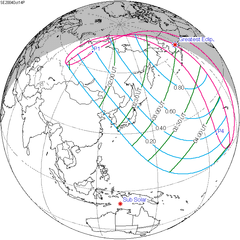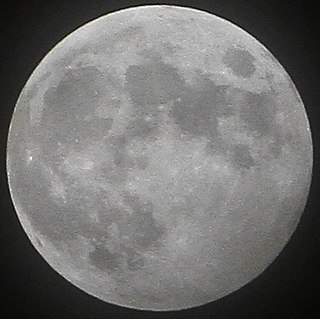
A penumbral lunar eclipse took place on Sunday, October 8, 1995, the second of two lunar eclipses in 1995, the first was a partial lunar eclipse on Saturday, April 15.

A penumbral lunar eclipse took place on Sunday, October 8, 1995, the second of two lunar eclipses in 1995, the first was a partial lunar eclipse on Saturday, April 15.
This is the first of four lunar year eclipses at the descending node of the Moon's orbit.
| Lunar eclipse series sets from 1995–1998 | ||||||||
|---|---|---|---|---|---|---|---|---|
| Ascending node | Descending node | |||||||
| Saros Photo | Date Viewing | Type Chart | Gamma | Saros Photo | Date Viewing | Type Chart | Gamma | |
| 112 | 1995 Apr 15  | Partial | −0.95939 | 117 | 1995 Oct 08  | Penumbral | 1.11794 | |
122 | 1996 Apr 04  | Total | −0.25339 | 127 | 1996 Sep 27  | Total | 0.34264 | |
132 | 1997 Mar 24  | Partial | 0.48990 | 137 | 1997 Sep 16  | Total | −0.37684 | |
| 142 | 1998 Mar 13  | Penumbral | 1.19644 | 147 | 1998 Sep 06  | Penumbral | −1.10579 | |
| Last set | 1994 May 25 | Last set | 1994 Nov 18 | |||||
| Next set | 1999 Jan 31 | Next set | 1998 Aug 08 | |||||
It was part of Saros series 117.
A lunar eclipse will be preceded and followed by solar eclipses by 9 years and 5.5 days (a half saros). [1] This lunar eclipse is related to two solar eclipses of Solar Saros 124.
| October 3, 1986 | October 14, 2004 |
|---|---|
 |  |

A penumbral lunar eclipse took place on April 24, 2005, the first of two lunar eclipses in 2005. At maximum eclipse, 86.5% of the Moon's disc was partially shaded by the Earth, which caused a slight shadow gradient across its disc; this subtle effect may have been visible to careful observers. No part of the Moon was in complete shadow. The eclipse lasted 4 hours and 6 minutes overall, and was visible from east Asia, Australia, and the Americas.

A partial lunar eclipse took place on 7 September 2006, the second of two lunar eclipses in 2006. The tables below contain detailed predictions and additional information on the Partial Lunar Eclipse of 7 September 2006.

A penumbral lunar eclipse took place on November 20, 2002, the last of three lunar eclipses in 2002.

A penumbral lunar eclipse took place on 18–19 October 2013, the last of three lunar eclipses in 2013.

A penumbral lunar eclipse took place on Friday, March 13, 1998, the first of three lunar eclipses in 1998.

A partial lunar eclipse took place on Saturday, April 15, 1995, the first of two lunar eclipses in 1995, the second being with a penumbral lunar eclipse on Sunday, October 8.
A partial lunar eclipse took place on Saturday, August 27, 1988, the second of two lunar eclipses in 1988, the first being on March 3, 1988. The Earth's shadow on the Moon was clearly visible in this eclipse, with 29.159% of the Moon in shadow; the partial eclipse lasted for 1 hour, 52 minutes and 59.7 seconds. The Moon was only 5 hours and 48 minutes before perigee, making it 6.3% larger than average

A penumbral lunar eclipse took place on Thursday, June 27, 1991, the second of four lunar eclipses in 1991. The moon entered the Earth's penumbra for about 3 hours, and was difficult to see. This lunar eclipse is the predecessor of the Solar eclipse of July 11, 1991.

A penumbral lunar eclipse took place on Wednesday, January 30, 1991, the first of four lunar eclipses in 1991.
A penumbral lunar eclipse took place on Thursday, November 8, 1984, the last of three lunar eclipses in 1984. This subtle penumbral eclipse may have been visible to a skilled observer at maximum eclipse. 90% of the Moon's disc was partially shaded by the Earth, which caused a gentle shadow gradient across its disc at maximum; the eclipse as a whole lasted 4 hours and 28 minutes.
A penumbral lunar eclipse took place on Tuesday, May 15, 1984, the first of three lunar eclipses in 1984. This was a deep penumbral eclipse, with the southern limb of the Moon close to the Earth's shadow.

A penumbral lunar eclipse occurred on Friday, 5 May 2023, the first of two lunar eclipses in 2023. The moon's apparent diameter was 0.1% larger than average because it occurred 5.5 days before perigee. This was the deepest penumbral eclipse since February 2017 and until September 2042.

A penumbral lunar eclipse took place on 30 November 2020. A penumbral lunar eclipse occurs at full moon when the Moon passes through Earth's penumbral shadow.
A penumbral lunar eclipse will take place on Monday, March 25, 2024. It will be visible to the naked eye as 95.57% of the Moon will be immersed in Earth's penumbral shadow.
A penumbral lunar eclipse took place on Tuesday, September 27, 1977, the second of two lunar eclipses in 1977. At maximum eclipse, 90.076% of the Moon's disc was partially shaded by the Earth, which caused a slight shadow gradient across its disc; this subtle effect may have been visible to careful observers. No part of the Moon was in complete shadow. The eclipse lasted 4 hours, 17 minutes and 35.5 seconds overall. Occurring 6.2 days before apogee, the Moon's apparent diameter was 2.2% smaller than average.
A partial lunar eclipse took place on Thursday, May 13, 1976, the first of two lunar eclipses in 1976, the second being a penumbral lunar eclipse on November 6, 1976. At maximum eclipse, a small bite out of the Moon should have been visible. The eclipse lasted for 1 hour, 15 minutes and 23.8 seconds, with just 12.17% of the Moon in shadow at maximum. Occurring only 1.1 days after perigee, the Moon's apparent diameter 5.4% larger than average.

A penumbral lunar eclipse took place on Friday, June 15, 1973, the second of four lunar eclipses in 1973, the first was a penumbral lunar eclipse on Thursday, January 18, the third being with a penumbral lunar eclipse on Sunday, July 15, and the last being with a partial lunar eclipse on Monday, December 10.
A penumbral lunar eclipse took place on Saturday, November 6, 1976, the second of two lunar eclipses in 1976, the first being on May 13. This subtle penumbral eclipse may have been visible to a skilled observer at maximum eclipse. 83.827% of the Moon's disc was partially shaded by the Earth, which caused a gentle shadow gradient across its disc at maximum; the eclipse as a whole lasted 4 hours, 25 minutes and 52.1 seconds. Occurring only 0.3 days after apogee, the moon's apparent diameter was 6.5% smaller than average.

A total lunar eclipse took place on Wednesday, October 18, 1967, the second of two total lunar eclipses in 1967, the first being on April 24, 1967.

A penumbral lunar eclipse took place on Thursday, September 25, 1969, the last of three penumbral lunar eclipses in 1969, the first being on Wednesday, April 2, and the second being on Wednesday, August 27. At maximum eclipse, 90% of the Moon's disc was partially shaded by the Earth, which caused a slight shadow gradient across its disc; this subtle effect may have been visible to careful observers. No part of the Moon was in complete shadow. The eclipse lasted 4 hours and 5 minutes overall.